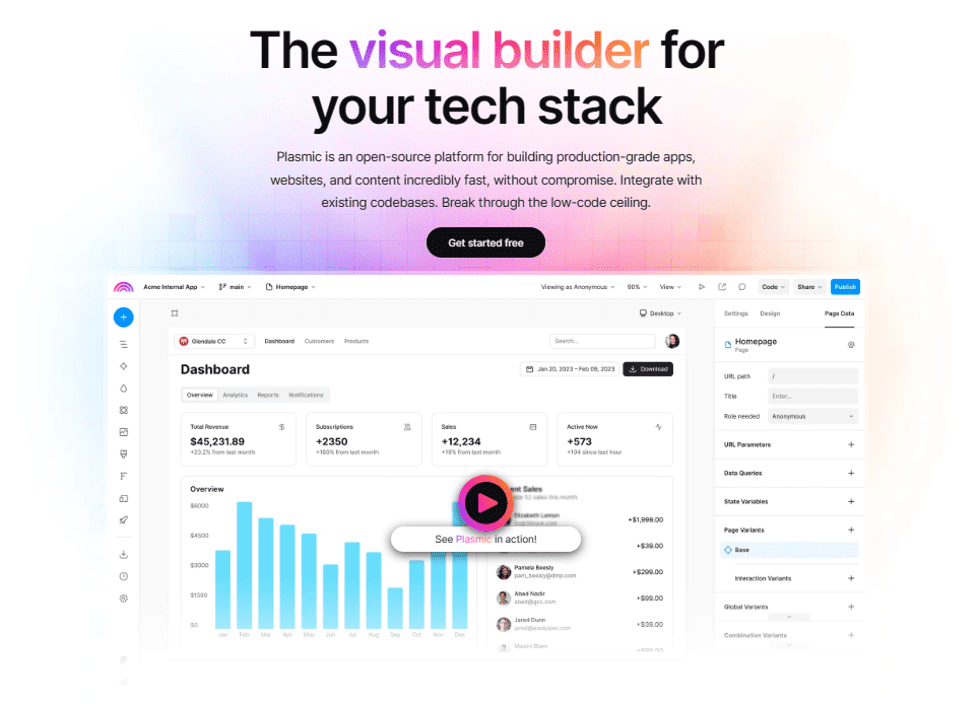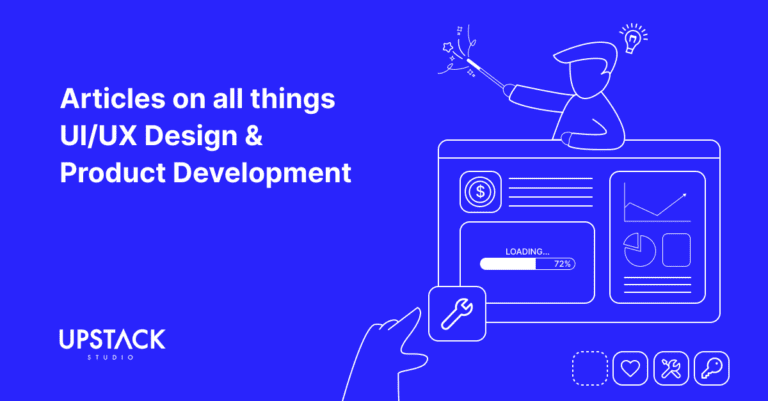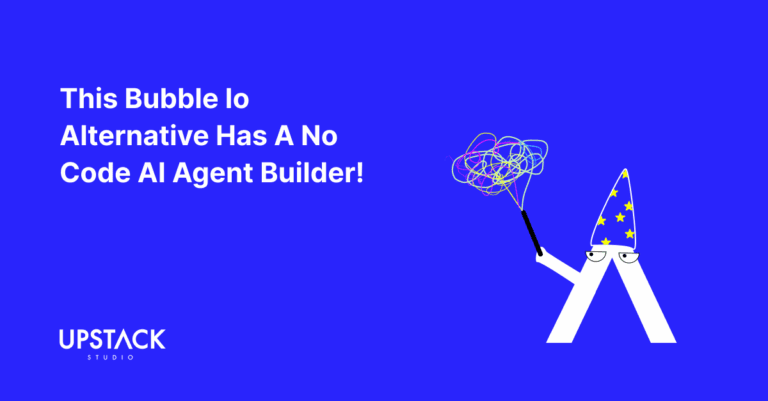The age old no code problem
Even great no code app builders eventually force founders to compromise on their app.
It’s just the way a no code building environment works – as covered in our post on why no code SaaS is not ideal long term.

If founders don’t want to compromise, the next realistic step is transitioning to custom code.
This is a pain in the ass.
Or more like, a pain in the SaaS!
And so, we’ve been searching for a solution that lets no-coders and developers work together on the same project and platform over the app’s entire lifetime.
We found the solution
After trying many no code app builders, we finally found Plasmic!

We believe it has huge potential to change how founders and developers collaborate.
Plasmic is perfect for you if…
- you’re planning to build a new app
- you’re unhappy with your current app builder
- your project will likely need custom development
To convince you, we’ll share four unique strengths of Plasmic:
- Developer-friendly features
- Extensive customization
- Open source codebase
- A great team
That’s right, Plasmic is that one girl who is actually not like the other girls!

The takeaway: Plasmic is the first no code app builder we’ve seen where developers and non tech founders can collaborate without either having to compromise.
Benefits of Plasmic No Code App Builder
Developer-friendly features
Professional developers and designers love the convenience of no code.
We just can’t afford the drawbacks of a typical no code app builder, namely:
- lack of customization, and
- lack of control
The Plasmic team understands this and offers a host of features that cater to developers.
There are two we’d like to highlight – pardon the incoming nerdiness.
1. Code Export

Plasmic allows users to export their source code using a feature called CodeGen.
This means we’re free to use Plasmic the app builder as nothing but an app builder.
In contrast, many no code platforms lock you in, forcing you to use their hosting services.
Whatever you build with Plasmic, you’re free to export and deploy on another platform.
This is a freedom most developers insist on.
Aside from marriage, we don’t want to be locked into any platform, ever.
2. Custom Component Import
On Plasmic, not only can code be exported but it can also be imported.

What you’re looking at here is a custom component written outside of Plasmic being integrated into the platform.
And rendered pretty damn accurately too.

If you’re not sure why we’re impressed, imagine being able to convert a PDF into a Word document while keeping the formatting identical.
And Plasmic integrates into many frameworks, including popular ones like React, Next.js, Angular and VueJS.
This gives developers the freedom to write and design using their preferred frameworks.
By benefiting developers, Plasmic benefits non tech founders, which brings us to its second strength.
Extensive customization
Here’s the deal with those 40 app builders we’ve tried out.
They come in two versions:
- They pre-build everything, you drag and drop with no customization.
- They allow limited customization using their terrible proprietary builder.
This applies even to the ones that say ‘you can build complex apps’.
Thing is, your app may one day need a feature only possible with fully custom code.

It could be never, it could be two years from now, and it could be tomorrow.
On a typical no code platform, you’d be dreading the hassle and downtime of migrating.
If your app was on Plasmic, it would be business as usual as your no code project can be extended with broad customization options.

If prebuilt functions are all you need, you do it yourself.
If you need a custom function, hire a developer to build and directly integrate it.
Open source codebase
Unlike other equally feature-rich app builders out there, Plasmic is open-source.
This means it doesn’t need the Plasmic founders and official team to keep it going.
Your app won’t fall victim to a failing company or predatory pricing change that makes the current platform unusable to you.
Many new founders downplay the importance of this insurance – til it happens to them.
We hate beating a dead horse.
Actually, we love beating dead horses.
So, for the umpteenth time, here’s a great example of why most developers prefer open-source frameworks.

Bubble.io, perhaps the most popular no code app builder, implemented a huge change in pricing mid 2023.
Forcing a three-year user to jump from $130 a month to $1,500 is not good.
And because apps built on Bubble use their proprietary codebase, it’s stuck there.
If ransomware was legal, this would be it.
We predict Plasmic will gain a lot of traction amongst developers and corporations like React did. In fact, Plasmic began as an enterprise solution and serves several notable clients like Intuit, Envato, and Scale AI.
Generally, if it’s good enough for big corporates, it’s good enough for us small guys.
Now, time for the last point, something we feel many overlook but shouldn’t.
The Plasmic team knows their stuff
The Upstack Studio team actually got on a call with one of the co-founders of Plasmic, Yang.
These are our takeaways:
- Yang and his co-founder Chung Wu are both tech guys with first-hand experience.
- Plasmic has funding and is already revenue-funded by enterprise clients.
- They are very active in helping set their users up for success.
This assures us for two reasons.
For one, being tech people with industry experience means they have lived through the pain points they are solving, and have the hard skills to build the solution themselves.
For another, being revenue-generating while having funding means they are likely in a financially stable position and will be around for a while.
Limitations of Plasmic
Even though Plasmic is probably the best no code app builder we’ve come across, it’s still not perfect.
Specifically, Plasmic has two limitations we should highlight.
First limitation: Less emphasis on mobile apps
If you go through their product showcase, you’ll see a heavy bias towards web apps.

This is reflected in the frameworks they integrate with – it’s mostly web-focused.
Not to say you can’t build a mobile app on Plasmic – but your app won’t deliver a fully native experience optimized for Android or iOS.
Second limitation: No AI generator
If no code had a first-world problem, this would be it.
That said, we’ve seen how fast early app development can be with generative AI – check out our piece on the new Flutterflow AI Gen feature.
Plasmic doesn’t currently offer that, so you won’t be able to spam out designs.
BUT – It’s a good thing if you ask us.
AI tends to make people think they can get a complete app without doing anything.
It doesn’t work that way, and likely never will.
These are minor issues. Bubble and Flutterflow started out focusing on web and mobile respectively, today they offer both.
But they will never offer the strengths of Plasmic – so I choose Plasmic.
But you’re a founder, not a donkey, so you decide.
Conclusion: Give Plasmic a try!
Plasmic is the first no code app builder we’ve seriously considered including in the Upstack Studio tech stack.
And we want you to experience it first hand.
So, we’ve partnered with Plasmic to offer our readers two months of free unlimited access to Plasmic for an unlimited number of users!
Whenever you’re reading this, there’s a good chance the promotion is still valid.
Just follow this link and click on the sign-up button – you can’t miss it.

Two months of full Plasmic access gives you more than enough time to experience the extensive customization capabilities of Plasmic.
You might even be able to import an existing project and work on it!
Time for you and Plasmic to team up and do awesome things together.
Hey there stranger, thanks for reading all the way to the end. Consider joining our mailing list for a one-stop resource on everything from micro SaaS validation all the way to execution and promotion. Get a nifty list of questions to ask app developers when you sign up!
App Developer Interview Questions Template
Download this template now so you know exactly what to ask App Development Agencies! Let us know where should we send it through the form below.




